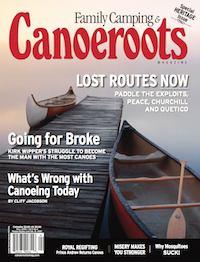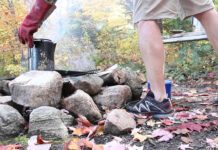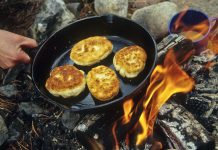With apologies to Napoleon and his dictum that an army marches on its stomach, paddlers know that canoe trippers float on their bellies. Nutritious, delicious and non-perishable food is the fuel you need to power your canoe every day.
Before forking over for freeze-dried food in fancy packaging, consider that paddlers used to nourish themselves for months at a time on simple dried foods like cracked corn, beans and pemmican. Foods that are dried slowly are nutritionally superior to canned food, often don’t require added chemicals or preservatives, are simple to pack, easy to prepare, offer an unbeatable calorie-to-gram ratio and can keep for years.
So how do you dehydrate your own food? Well, you can experiment with drying over a forced-air heat register, or by building your own dehydrator with some plywood, screening, a light bulb, a fan and a thermometer. Or you can buy your own simple, reliable and inexpensive unit from companies such as American Harvest.
Start at the grocery store. It doesn’t matter if the food is fresh or comes in a can, in a jar or from the freezer. Read your dehydrator’s instructions, plug it in, spread the food across the drying trays and sit back and wait. Once you see how simple it is, you’ll realize your next trip’s menu is limited only by your imagination.
Vegetables
Vegetables bring variety and colour to any meal and are important for their nutritional value. You can even use bags of frozen peas, beans, corn, carrots—they all dry very nicely with no washing or chopping necessary.
Canned Beans
Canned beans are nutritious, cheap and easy to dry. The standard “baked beans in tomato sauce” are a snap to rehydrate. Mix a variety of beans with slices of rehydrated vegetables and rice for a simple, nutritious meal.
Applesauce
Use applesauce for fruit leathers. Applesauce is full of pectin, which binds the goopy mess into a tough sheet of “leather” when dried. Just spread the mixture onto plastic sheets that come with the dehydrator. The leather can be eaten as a snack, or rehydrated into a sauce for bannock or pancakes.
Beef
Make up a batch of beef jerky for your carnivorous friends. Cure lean ground beef with curing salts, add your favourite spices, roll into three-millimetre thick strips and dry for five to eight hours.
Spaghetti Sauce and Salsa
Spaghetti sauce and salsa resemble the sole of an old leather shoe when dehydrated. They rehydrate back into a remarkable resemblance of the original after just a few minutes in hot water. But don’t buy cheap spaghetti sauce!
It usually has a higher water content, and takes longer to dry. Gourmet brands with large pieces of vegetables should be blended before drying.
Max Finkelstein canoed solo across Canada between 1997 and 1999.









